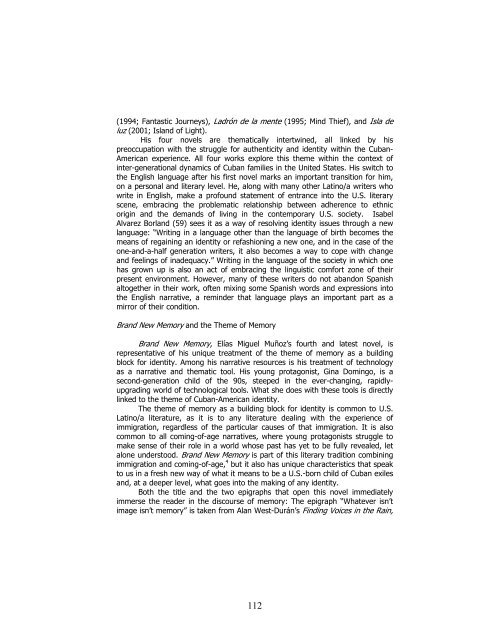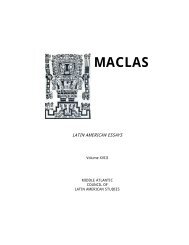latin american essays maclas
latin american essays maclas
latin american essays maclas
Create successful ePaper yourself
Turn your PDF publications into a flip-book with our unique Google optimized e-Paper software.
(1994; Fantastic Journeys), Ladrón de la mente (1995; Mind Thief), and Isla de<br />
luz (2001; Island of Light).<br />
His four novels are thematically intertwined, all linked by his<br />
preoccupation with the struggle for authenticity and identity within the Cuban-<br />
American experience. All four works explore this theme within the context of<br />
inter-generational dynamics of Cuban families in the United States. His switch to<br />
the English language after his first novel marks an important transition for him,<br />
on a personal and literary level. He, along with many other Latino/a writers who<br />
write in English, make a profound statement of entrance into the U.S. literary<br />
scene, embracing the problematic relationship between adherence to ethnic<br />
origin and the demands of living in the contemporary U.S. society. Isabel<br />
Alvarez Borland (59) sees it as a way of resolving identity issues through a new<br />
language: “Writing in a language other than the language of birth becomes the<br />
means of regaining an identity or refashioning a new one, and in the case of the<br />
one-and-a-half generation writers, it also becomes a way to cope with change<br />
and feelings of inadequacy.” Writing in the language of the society in which one<br />
has grown up is also an act of embracing the linguistic comfort zone of their<br />
present environment. However, many of these writers do not abandon Spanish<br />
altogether in their work, often mixing some Spanish words and expressions into<br />
the English narrative, a reminder that language plays an important part as a<br />
mirror of their condition.<br />
Brand New Memory and the Theme of Memory<br />
Brand New Memory, Elías Miguel Muñoz’s fourth and latest novel, is<br />
representative of his unique treatment of the theme of memory as a building<br />
block for identity. Among his narrative resources is his treatment of technology<br />
as a narrative and thematic tool. His young protagonist, Gina Domingo, is a<br />
second-generation child of the 90s, steeped in the ever-changing, rapidlyupgrading<br />
world of technological tools. What she does with these tools is directly<br />
linked to the theme of Cuban-American identity.<br />
The theme of memory as a building block for identity is common to U.S.<br />
Latino/a literature, as it is to any literature dealing with the experience of<br />
immigration, regardless of the particular causes of that immigration. It is also<br />
common to all coming-of-age narratives, where young protagonists struggle to<br />
make sense of their role in a world whose past has yet to be fully revealed, let<br />
alone understood. Brand New Memory is part of this literary tradition combining<br />
immigration and coming-of-age, 4 but it also has unique characteristics that speak<br />
to us in a fresh new way of what it means to be a U.S.-born child of Cuban exiles<br />
and, at a deeper level, what goes into the making of any identity.<br />
Both the title and the two epigraphs that open this novel immediately<br />
immerse the reader in the discourse of memory: The epigraph “Whatever isn’t<br />
image isn’t memory” is taken from Alan West-Durán’s Finding Voices in the Rain,<br />
112




